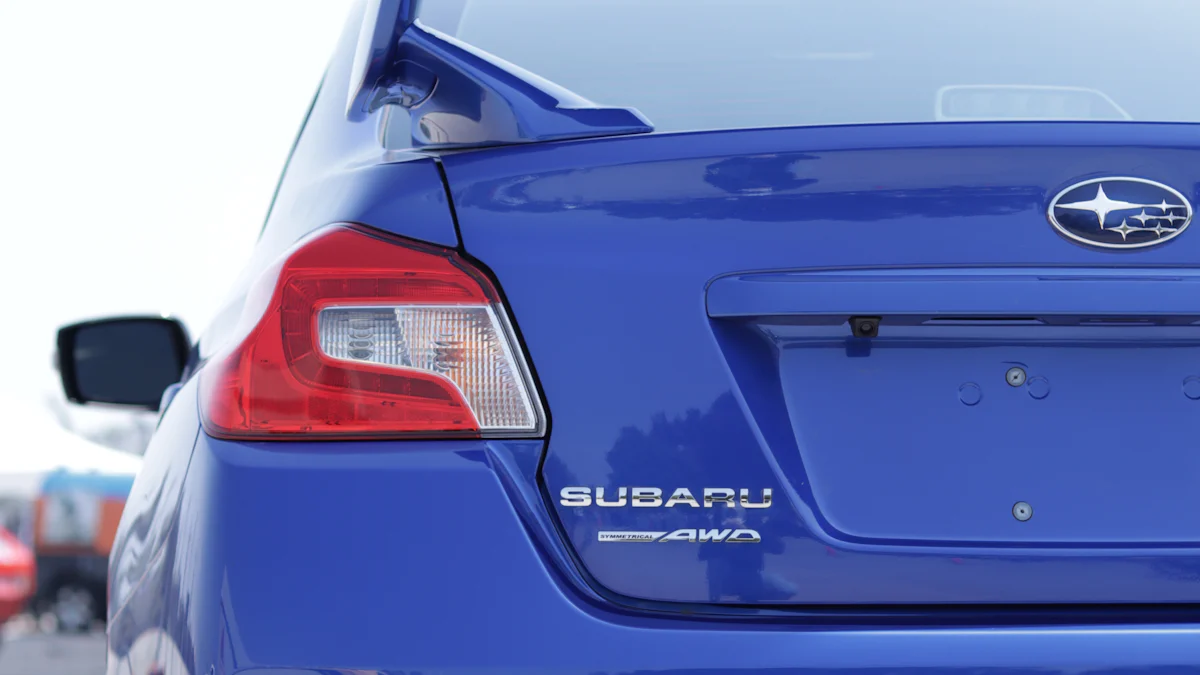Die Vor- und Nachteile gängiger Materialien für Heckspoiler

Choosing the right rear splitter material plays a vital role in your vehicle’s performance and durability. The material directly impacts how well the splitter manages airflow, reduces drag, and enhances downforce. This improvement in aerodynamics translates to better handling and stability, especially at high speeds. Materials like carbon fiber, aluminum, and ABS plastic each offer unique benefits and drawbacks, making it essential to evaluate your priorities. Factors such as weight, strength, and cost should guide your decision to ensure the splitter aligns with your driving needs and goals.
Wichtigste Erkenntnisse
Carbon fiber is ideal for high-performance vehicles due to its lightweight and strong properties, enhancing speed and handling.
Aluminum offers a balance of durability and cost-effectiveness, making it suitable for daily drivers and moderate performance builds.
ABS plastic is the most budget-friendly option, providing flexibility and ease of installation, perfect for casual use and DIY projects.
Consider the impact of material choice on aerodynamics; lighter materials improve airflow and reduce drag, while rigidity affects performance at high speeds.
Evaluate your driving needs and budget when selecting a splitter material to ensure it aligns with your performance goals and aesthetic preferences.
Regular maintenance can extend the lifespan of your splitter; inspect for damage and protect against environmental factors to maintain functionality.
Investing in premium materials like carbon fiber is worthwhile for enthusiasts seeking top-tier performance, while aluminum and ABS plastic serve practical purposes for everyday use.
Carbon Fiber Rear Splitters

Carbon fiber stands out as one of the most sought-after materials for rear splitters, especially in high-performance automotive applications. Its unique properties make it a top choice for those who value both functionality and aesthetics.
Pros of Carbon Fiber
Lightweight properties that improve vehicle performance.
Carbon fiber is incredibly lightweight, which directly enhances your vehicle’s performance. A lighter rear splitter reduces the overall weight of your car, improving acceleration and fuel efficiency. This weight reduction also contributes to better handling, especially during high-speed maneuvers.
Exceptional strength-to-weight ratio for durability.
Despite its lightness, carbon fiber offers exceptional strength. Its high strength-to-weight ratio ensures that the rear splitter can withstand significant aerodynamic forces without compromising its structural integrity. This makes it a reliable choice for demanding driving conditions.
Premium aesthetic appeal with various weave patterns.
Carbon fiber is not just functional; it’s visually appealing. The material’s distinct weave patterns give your vehicle a sleek, high-end look. When light hits the surface, it creates a glossy sheen that enhances the overall aesthetic of your car. This premium appearance often makes carbon fiber a favorite among car enthusiasts.
Cons of Carbon Fiber
High cost compared to other materials.
The biggest drawback of carbon fiber is its cost. Manufacturing carbon fiber involves complex processes, which drive up its price. Compared to materials like ABS plastic or aluminum, carbon fiber is significantly more expensive, making it less accessible for budget-conscious drivers.
Susceptibility to cracking under heavy impact.
While carbon fiber is strong, it is not immune to damage. Under heavy impact, it can crack rather than bend, unlike more flexible materials such as ABS plastic. This susceptibility to cracking means you need to handle it with care, especially in environments where impacts are likely.
Ideal Applications for Carbon Fiber
Best suited for high-performance vehicles and track use.
Carbon fiber rear splitters excel in high-performance settings. If you drive a sports car or participate in track events, this material provides the perfect balance of weight reduction and durability. Its ability to enhance aerodynamics makes it ideal for achieving optimal performance on the track.
Ideal for enthusiasts prioritizing weight reduction and aesthetics.
If you prioritize aesthetics and weight reduction, carbon fiber is an excellent choice. Its lightweight nature improves your car’s performance, while its premium appearance elevates the overall look of your vehicle. For enthusiasts who value both form and function, carbon fiber delivers on all fronts.
Aluminum Rear Splitters
Aluminum rear splitters offer a practical and versatile option for many drivers. Known for their durability and adaptability, these splitters strike a balance between performance and affordability. If you’re looking for a material that can handle daily driving while still delivering solid aerodynamic benefits, aluminum might be the right choice.
Pros of Aluminum
Durable and resistant to corrosion.
Aluminum stands out for its ability to resist rust and corrosion. This makes it an excellent choice for vehicles exposed to varying weather conditions. Unlike materials that degrade over time due to moisture or road salt, aluminum maintains its structural integrity, ensuring long-term reliability.
Lightweight and cost-effective compared to carbon fiber.
While not as light as carbon fiber, aluminum still offers a favorable weight-to-strength ratio. It provides a lightweight solution without the hefty price tag associated with premium materials. This makes it a budget-friendly option for those who want improved performance without overspending.
Easy to fabricate into custom designs.
Aluminum’s malleability allows for easy customization. You can shape it into unique designs to match your vehicle’s specific needs. Whether you’re aiming for a sleek aesthetic or a functional aerodynamic improvement, aluminum can be tailored to meet your goals.
“Materials such as plywood, aluminum, signboard, and carbon fiber wrapped foam all work well. The material you choose is entirely up to personal preference and how destructive you are going to be with the parts.” – Automotive Customization Expert
Cons of Aluminum
Prone to bending or denting under heavy impact.
Although aluminum is durable, it is not immune to damage. Under significant force, it tends to bend or dent rather than crack. This flexibility can be both an advantage and a drawback, depending on the level of impact your vehicle encounters.
Slightly heavier than carbon fiber.
Compared to carbon fiber, aluminum is heavier. While this difference may not drastically affect performance for most drivers, it could be a consideration for those focused on extreme weight reduction for track use or high-performance builds.
Ideal Applications for Aluminum
Suitable for daily drivers and moderate performance builds.
Aluminum rear splitters are perfect for everyday vehicles. They provide a balance of durability and performance, making them ideal for moderate builds. If you’re not pushing your car to its limits on the track, aluminum offers a reliable and cost-effective solution.
Great for those seeking a balance between cost and durability.
If you want a splitter that lasts without breaking the bank, aluminum is a smart choice. It delivers solid performance and longevity, making it a favorite among drivers who value practicality and affordability.
ABS Plastic Rear Splitters

ABS plastic rear splitters have gained popularity among car enthusiasts and DIY builders. Their affordability, flexibility, and ease of installation make them a practical choice for many drivers. If you’re looking for a budget-friendly option that still delivers functional benefits, ABS plastic might be the material for you.
Pros of ABS Plastic
Affordable and widely available.
ABS plastic stands out as one of the most cost-effective materials for rear splitters. Its affordability makes it accessible to a wide range of drivers, from casual car owners to automotive hobbyists. You can find ABS plastic splitters in various designs and sizes, ensuring you have plenty of options to suit your vehicle.
Flexible and resistant to minor impacts.
The flexibility of ABS plastic allows it to absorb minor impacts without cracking or breaking. This resilience makes it ideal for everyday driving, where occasional bumps or scrapes are inevitable. Unlike rigid materials, ABS plastic bends slightly under pressure, reducing the risk of permanent damage.
Lightweight and easy to install.
ABS plastic is lightweight, which simplifies the installation process. You can handle and position the splitter with ease, even if you’re working on it alone. Its light weight also minimizes the added load on your vehicle, preserving its performance and fuel efficiency.
“ABS plastic is a common choice due to its lightweight nature, ease of molding, and affordability.” - DIY Enthusiasts
Cons of ABS Plastic
Less durable over time, prone to warping.
While ABS plastic offers flexibility, it lacks long-term durability. Prolonged exposure to heat or harsh weather conditions can cause the material to warp or degrade. This makes it less suitable for drivers who need a splitter that can withstand extreme environments.
Limited aesthetic appeal compared to carbon fiber.
ABS plastic doesn’t provide the premium look that materials like carbon fiber offer. Its surface lacks the glossy finish and intricate weave patterns that enhance a vehicle’s visual appeal. If aesthetics are a top priority, ABS plastic may not meet your expectations.
Ideal Applications for ABS Plastic
Best for budget-conscious drivers.
If you’re working within a tight budget, ABS plastic is an excellent choice. It delivers functional benefits without the high cost of premium materials. For drivers who prioritize practicality over luxury, ABS plastic offers great value.
Suitable for casual use and aesthetic upgrades.
ABS plastic works well for casual drivers who want to enhance their vehicle’s appearance without investing heavily. It’s also a good option for those experimenting with custom designs or DIY projects. You can easily modify and install ABS plastic splitters to achieve the look you desire.
Comparing Rear Splitter Designs and Material Impact
How Material Choice Affects Aerodynamics
The role of weight and rigidity in airflow management.
The material of your rear splitter plays a crucial role in managing airflow around your vehicle. Lightweight materials like carbon fiber reduce the overall weight of your car, allowing for smoother airflow and less drag. Rigidity also matters. A stiffer material ensures that the splitter maintains its shape under high-speed conditions, which helps direct airflow effectively. Flexible materials, while more impact-resistant, may not provide the same level of aerodynamic precision.
Differences in performance between lightweight and heavier materials.
Lightweight materials, such as carbon fiber, excel in high-performance scenarios. They minimize drag and improve downforce, making them ideal for track use. Heavier materials, like aluminum, still offer solid aerodynamic benefits but may slightly reduce efficiency due to added weight. ABS plastic, while lightweight, lacks the rigidity needed for optimal airflow management, making it better suited for casual driving rather than competitive performance.
“Aerodynamic devices like diffusers and splitters significantly reduce drag by streamlining airflow and minimizing turbulence.” – Automotive Engineering Insights
Durability and Maintenance Considerations
Long-term wear and tear for each material.
Each material has unique durability characteristics. Carbon fiber resists wear but can crack under heavy impact. Aluminum withstands corrosion but may dent or bend over time. ABS plastic, while flexible, tends to warp or degrade when exposed to extreme heat or harsh weather. Understanding these tendencies helps you choose a material that aligns with your driving environment and maintenance capabilities.
Maintenance tips to extend the lifespan of rear splitters.
Proper care can extend the life of your rear splitter. For carbon fiber, avoid heavy impacts and regularly inspect for cracks. Aluminum splitters benefit from cleaning to prevent dirt buildup, which can lead to scratches. ABS plastic requires protection from prolonged sun exposure to prevent warping. Regular maintenance ensures that your splitter remains functional and visually appealing.
Cost vs. Performance Trade-offs
Balancing budget with desired performance outcomes.
When selecting a rear splitter, you must weigh cost against performance. Carbon fiber offers unmatched performance and aesthetics but comes at a premium price. Aluminum provides a middle ground, delivering durability and decent aerodynamics at a reasonable cost. ABS plastic is the most affordable option, making it ideal for budget-conscious drivers who prioritize practicality over high-end performance.
When to invest in premium materials like carbon fiber.
Investing in premium materials like carbon fiber makes sense if you prioritize performance and aesthetics. High-performance vehicles or track cars benefit the most from its lightweight and aerodynamic properties. However, for daily drivers or moderate builds, aluminum or ABS plastic may offer a better balance of cost and functionality.
“The choice of material impacts not only performance but also long-term costs. Premium materials like carbon fiber are worth the investment for enthusiasts seeking top-tier results.” – Automotive Customization Expert
Selecting the right rear splitter material depends on your specific needs and priorities. Carbon fiber offers unmatched strength and a premium look but comes at a high cost. Aluminum provides durability and customization options, making it a practical choice for daily drivers. ABS plastic stands out for its affordability and ease of installation, though it lacks long-term durability. Evaluate your budget, performance goals, and vehicle use to make an informed decision. Aligning the material with your design and application ensures optimal performance and satisfaction, whether you prioritize aesthetics, functionality, or cost-effectiveness.
